A) Balin's profits will discourage new firms from entering.
B) Balin's will increase its market price over the coming months.
C) Balin's is operating in the short run, but not the long run.
D) Balin's is operating in the long run.
Correct Answer

verified
Correct Answer
verified
Multiple Choice
The term allocative efficiency refers to
A) the level of output that coincides with the intersection of the MC and AVC curves.
B) minimization of the AFC in the production of any good.
C) the production of the product mix most desired by consumers.
D) the production of a good at the lowest average total cost.
Correct Answer

verified
Correct Answer
verified
Multiple Choice
All of the following statements apply to a purely competitive market in the long run, except
A) in the long run, all inputs are variable in quantity.
B) firms can expand their plant capacities in the long run.
C) total fixed costs remain constant even when output expands in the long run.
D) firms may enter or leave the industry in the long run.
Correct Answer

verified
Correct Answer
verified
True/False
When firms in a purely competitive industry are earning profits that are greater than normal, the supply of the product will tend to decrease in the long run.
Correct Answer

verified
Correct Answer
verified
Multiple Choice
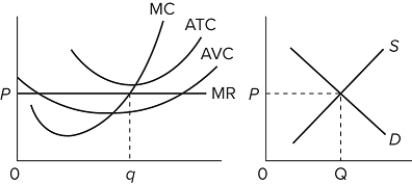 Refer to the diagrams, which pertain to a purely competitive firm producing output q and the industry in which it operates. Which of the following is correct?
Refer to the diagrams, which pertain to a purely competitive firm producing output q and the industry in which it operates. Which of the following is correct?
A) The diagrams portray neither long-run nor short-run equilibrium.
B) The diagrams portray both long-run and short-run equilibrium.
C) The diagrams portray short-run equilibrium but not long-run equilibrium.
D) The diagrams portray long-run equilibrium but not short-run equilibrium.
Correct Answer

verified
Correct Answer
verified
Multiple Choice
Much of Elon Musk's innovation success can be attributed to
A) ownership of patents that prevent rivals from competing in the relevant markets.
B) a systems engineering approach that finds more cost efficient ways to produce desired goods and services.
C) exclusive government contracts.
D) making small adjustments to already popular products.
Correct Answer

verified
Correct Answer
verified
Multiple Choice
Purely competitive industry X has decreasing costs and its product is an inferior good. The industry is currently in long-run equilibrium. The economy now goes into a recession and average incomes decline. The result will be
A) an increase in output and in the price of the product.
B) an increase in output, but not in the price of the product.
C) a decrease in the output, but not in the price of the product.
D) a decrease in output and in the price of the product.
Correct Answer

verified
Correct Answer
verified
Multiple Choice
Suppose that an industry's long-run supply curve is downsloping. This suggests that
A) it is an increasing-cost industry.
B) relevant inputs have become more expensive as the industry has expanded.
C) technology has become less efficient as a result of the industry's expansion.
D) it is a decreasing-cost industry.
Correct Answer

verified
Correct Answer
verified
Multiple Choice
Suppose an increase in product demand occurs in a decreasing-cost industry. As a result,
A) the new long-run equilibrium price will be lower than the original long-run equilibrium price.
B) equilibrium quantity will decline.
C) firms will eventually leave the industry.
D) the new long-run equilibrium price will be higher than the original price.
Correct Answer

verified
Correct Answer
verified
Multiple Choice
When a purely competitive firm is in long-run equilibrium, price is equal to
A) marginal cost but may be greater or less than average cost.
B) minimum average total cost and also to marginal cost.
C) minimum average cost but may be greater or less than marginal cost.
D) marginal revenue but may be greater or less than both average and marginal cost.
Correct Answer

verified
Correct Answer
verified
Multiple Choice
If a purely competitive firm is producing at the MR = MC output level and earning an economic profit, then
A) the selling price for this firm is above the market equilibrium price.
B) new firms will enter this market.
C) some existing firms in this market will leave.
D) there must be price fixing by the industry's firms.
Correct Answer

verified
Correct Answer
verified
Multiple Choice
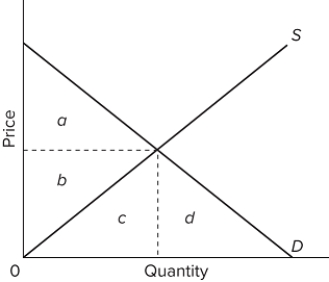 The accompanying graph represents the purely competitive market for a product. When the market is at equilibrium, the total opportunity cost of producing the equilibrium output level would be represented by the area
The accompanying graph represents the purely competitive market for a product. When the market is at equilibrium, the total opportunity cost of producing the equilibrium output level would be represented by the area
A) b + c.
B) b.
C) c.
D) a + b + c.
Correct Answer

verified
Correct Answer
verified
Multiple Choice
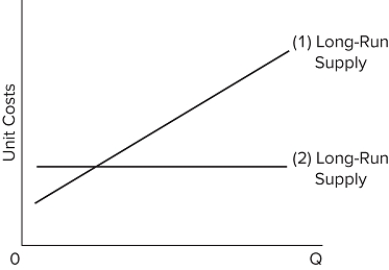 Line (2) in the diagram reflects a situation where resource prices
Line (2) in the diagram reflects a situation where resource prices
A) decline as industry output expands.
B) increase as industry output expands.
C) rise and then decline as industry output expands.
D) remain constant as industry output expands.
Correct Answer

verified
Correct Answer
verified
Multiple Choice
Which of the following would not be expected to occur in a purely competitive market in long-run equilibrium?
A) Consumer and producer surplus will be minimized.
B) P = MC = lowest ATC.
C) The maximum willingness to pay for the last unit equals the minimum acceptable price for that unit.
D) We would expect all of these to occur in the long run in a purely competitive market.
Correct Answer

verified
Correct Answer
verified
Multiple Choice
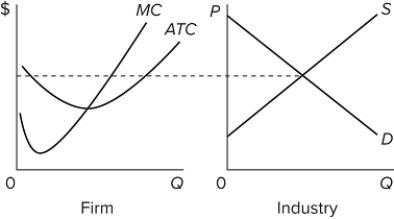 The graphs are for a purely competitive market in the short run. The graphs suggest that in the long run, assuming no changes in the given information,
The graphs are for a purely competitive market in the short run. The graphs suggest that in the long run, assuming no changes in the given information,
A) some firms will exit from this industry.
B) more buyers will come to the market.
C) new firms will be attracted into the industry.
D) buyers will leave the industry.
Correct Answer

verified
Correct Answer
verified
Multiple Choice
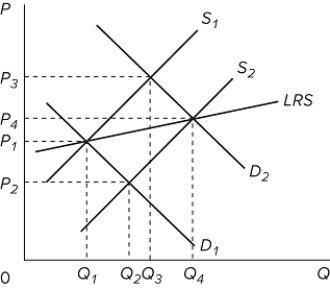 The industry represented by the accompanying graph must be one where
The industry represented by the accompanying graph must be one where
A) resource prices rise when the industry contracts.
B) resource prices fall when the industry expands.
C) resource prices fall when the industry contracts.
D) resource prices are unaffected by the industry's expansion.
Correct Answer

verified
Correct Answer
verified
Multiple Choice
Assume that society places a higher value on the last unit of X produced than the value of the resources used to produce that unit. With no spillovers, this information means that
A) total cost is greater than total revenue.
B) price is greater than marginal cost.
C) marginal cost is greater than price.
D) resources are being overallocated to X.
Correct Answer

verified
Correct Answer
verified
Multiple Choice
The long-run supply curve would be upward sloping if
A) resource prices fall as industry production contracts.
B) resource prices rise as industry production contracts.
C) resource prices are not affected by changes in industry output-level.
D) resource prices are set by the government.
Correct Answer

verified
Correct Answer
verified
Multiple Choice
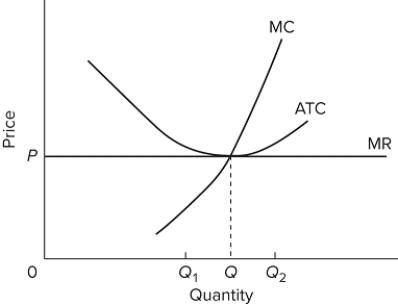 In the diagram, at output level Q1,
In the diagram, at output level Q1,
A) neither productive nor allocative efficiency is achieved.
B) both productive and allocative efficiency are achieved.
C) allocative efficiency is achieved, but productive efficiency is not.
D) productive efficiency is achieved, but allocative efficiency is not.
Correct Answer

verified
Correct Answer
verified
Multiple Choice
Assume a purely competitive firm is maximizing profit at some output at which long-run average total cost is at a minimum. Then
A) the firm is earning an economic profit.
B) there is no tendency for the firm's industry to expand or contract.
C) allocative but not productive efficiency is being achieved.
D) other firms will enter this industry.
Correct Answer

verified
Correct Answer
verified
Showing 21 - 40 of 250
Related Exams